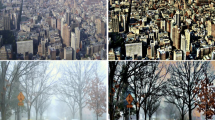Abstract
The physical properties of water cause light-prompted degradation of foggy images. The light quickly loses intensity as it goes in the water, depending upon the shading range wavelength. Visible light is consumed at the longest wavelength first. Red and blue are the most and least absorbed, respectively. Foggy images with low contrast, are captured due to the degradation effects of the light spectrum. Therefore, valuable information from these images cannot be fully extracted for further processing. In this paper, the authors have proposed a new method to increase contrast and reduce the noise of foggy images using CLAHE (Contrast Limited Adaptive Histogram Equalization) algorithm. The proposed method fuses the modification of image histogram into two main colour models, namely, Red–Green–Blue (RGB) and Hue-Saturation-Value (HSV). In the primary stage, the CLAHE is connected just on the red part as in water, red shading is more influenced than the blue or green shading. Furthermore, in the second stage, without influencing the hue, the CLAHE is connected to saturation and value components of the HSV colour model. Finally, enhanced image has been produced using a fusion of output of primary phase and output produced in the second phase. Two parameters, namely, RMSE (Root Mean Squared Error) and the PSNR (Peak Signal to Noise Ratio) have been considered in comparing the experimental results of the proposed system with state-of-the-art work.





Similar content being viewed by others
References
Abbasour MJ, Yazdi M, Masnadi-shirazi M (2016) A new fast method for foggy image enhancement. Proc 24th Iranian Conf Electric Eng (ICEE): 1855–1859
Anthoni JF (2005) Available via http://www.seafriends.org.nz/phgraph/water.htm
Anwar MI, Khosla A (2017) Vision enhancement through single image fog removal. Eng SciTechnol Int J 20(3):1075–1083
Dixit S, Tiwari SK, Sharma P (2016) Underwater image enhancement using DCP with ACCLAHE and homomorphism filtering. IEEE Int Conf Signal Process Commun Power Embedded Syst: 2042–2046
Guo JK, Sung CC, Chang HH (2014) Restoration of underwater vision using a two-phase regularization mechanism. Proc 2014 7th IEEE Int Conf Image Signal Process: 243–247
Iqbal K, Odetayo M, James A, Salam RA, Talib AZH (2010) Enhancing the low quality images using unsupervised colour correction method. IEEE Int Conf Syst Man Cybernet (SMC): 1703–1709
Kim K, Kim S, Kim KS (2018) Effective image enhancement techniques for fog-affected indoor and outdoor images. IET Image Process 12(4):465–471
Li C, Guo J, Chen S, Tang Y, Pang Y, Wang J (2016) Underwater image restoration based on minimum information loss principle and optical properties of underwater imaging. IEEE Int Conf Image Process (ICIP): 1993–1997
Lu H, Li Y, Serikawa S (2013) Underwater image enhancement using guided trigonometric bilateral filter and fast automatic colour correction. IEEE Int Conf Image Process: 3412–3416
Peng YT, Zhao X, Cosman PC (2015) Single underwater image enhancement using depth estimation based on blurriness. IEEE Int Conf Image Process (ICIP): 4952–4956
Sangeetha N, Anusudha K (2017) Image defogging using enhancement techniques. IEEE Int Conf Comput Commun Sign Process (ICCCSP): 1–5
Schechner YY, Karpel N (2005) Recovery of underwater visibility and structure by polarization analysis. IEEE J Ocean Eng 30(3):570–587
Tang K, Yang J, Wang J (2014) Investigating haze relevant features in a learning framework for image Dehazing. Comput Vision Pattern Recogn (CVPR): 2995–3002
Torres-Méndez LA, Dudek G (2005) Colour correction of underwater images for aquatic robot inspection. Proc Int Workshop Energy Mini Methods Comput Vision Pattern Recogn: 60–73
Wang Y, Ding X, Wang R, Zhang J, Fu X 2017. Fusion-based underwater image enhancement by wavelet decomposition. IEEE Int Conf Indust Technol (ICIT): 1013–1018
White EM, Partridge UC, Church SC (2003) Ultraviolet dermal reflection and mate choice in the guppy. Anim Behav 65(4):693–700
Xu Y, Lu Y (2015) Adaptive weighted fusion: a novel fusion approach for image classification. Neurocomputing 168:566–574
Xu Y, Wen J, Fei L, Zhang Z (2015) Review of video and image defogging algorithms and related studies on image restoration and enhancement. IEEE Access 4:165–188
Zhao X, Jin T, Qu S (2015) Deriving inherent optical properties from background colour and underwater image enhancement. Ocean Eng: 163–172
Author information
Authors and Affiliations
Corresponding author
Ethics declarations
Conflict of interest
Authors have no conflicts of interest in this work.
Additional information
Publisher’s Note
Springer Nature remains neutral with regard to jurisdictional claims in published maps and institutional affiliations.
Rights and permissions
About this article
Cite this article
Kumar, M., Jindal, S.R. Fusion of RGB and HSV colour space for foggy image quality enhancement. Multimed Tools Appl 78, 9791–9799 (2019). https://doi.org/10.1007/s11042-018-6599-8
Received:
Revised:
Accepted:
Published:
Issue Date:
DOI: https://doi.org/10.1007/s11042-018-6599-8




